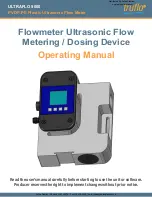
7. OPERATION
The vortex flowmeter outputs signals from the
specified terminals when the measured fluid begins
to flow after the following:
1 The flowmeter has been installed on the piping
2 The input/output terminals have been wired
3 The required parameters have been set
This section describes test methods before
operation and adjustment methods during trial
operation.
CAUTION
The parameter settings in "3" above have already
been set before shipment from the factory
according to the sizing data when ordering.
Therefore, it is not necessary to set the initial
parameters except when design (measurement)
conditions are changed.
7.1 Adjustments
7.1.1 Zero Adjustment
Zero adjustment is not necessary since the zero
point does not shift.
The zero point of a vortex flowmeter is stable as it
incorporates a frequency output sensor. However,
because of the effect of electrical noise and
vibration noise, the vortex flowmeter may output
even when the flowrate is zero. In this case, read
"7.2 Adjustment for Manual Mode".
7.1.2 Span Adjustment
Span adjustment (adjustment of 4 to 20 mA DC
output) is not necessary after the span has been set
and changed.
To check the output of 4 to 20 mA DC, read "7.1.3
Loop Test".
7.1.3 Loop Test
-2.5% to 110.0% (parameter J10: Test analog
output) can be output at 4 to 20 mA DC output
and 0 Hz to 10000 Hz (parameter J20: Test pulse
output) can be output at pulse output to check loop
or analog output. (In the case of an indicator, output
is either current or pulse.) To check analog output,
follow the "Check Procedure" below.
IMPORTANT
• When using a measuring instrument, do not
ground that instrument.
• Settings are canceled if the vortex flowmeter
is turned OFF within 30 seconds of setting
parameters. After setting, do not turn the power
supply OFF for 30 seconds or more.
Check Procedure
1.
Connect the instruments as shown in Figure 7.1, and
warm up for three minutes more.
2.
Set parameter J05/Test mode to "Analog output".
(Set "1" on the indicator.)
3.
Set parameter J10/Test analog output to "100%".
4.
When the load resistance is 250Ω, the digital
multimeter indicates 5V. When a known load
resistance (R
Ω
) is used, make sure that R(Ω) x 0.02
(A). Check that the output value is in the rated value
(±0.016 mA).
5.
Next, check that the output value is in the rated value
(±0.016 mA) after setting parameter J10/Test analog
output to 50%.
6.
Then, check that the output value is in the rated
value (±0.016 mA) after setting parameter J10/Test
analog output to 0%.
F0701.ai
250
Ω
24V DC
±10%
digital
multimeter
Relaying
Terminals
+
−
HART Configuration Tool
SUPPLY
SUPPLY
Figure 7.1 Connection Method
<7. Operation>
39
IM 01F07A01-01EN
Operation
7











































